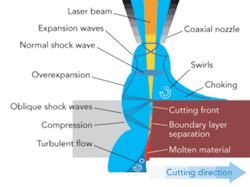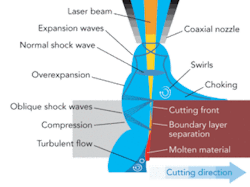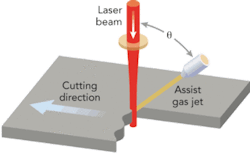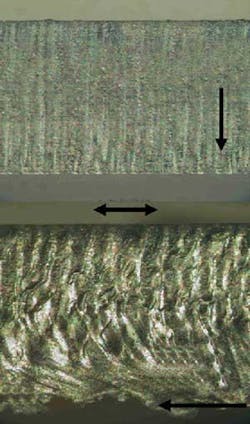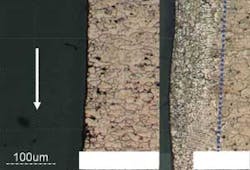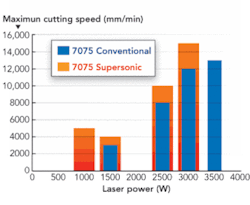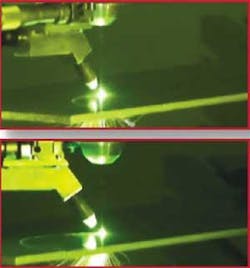LASER CUTTING aerospace aluminum
A. Riveiro, F. Quintero, J. Pou, F. Lusquiños, R. Comesaña, J. del Val, M. Boutinguiza, and R. Soto
Cutting with supersonic off-axis nozzles improves productivity and finishing of aluminum alloys
One of the mostremarkable facts of history is the birth of aerial transportation in 1793, with the flight of a hot air balloon designed by the Montgolfier brothers. Successive improvements were achieved during the aerial age, including the historic flight of the Wright brothers from Kitty Hawk, NC, in 1903. Today air transport is experiencing unstoppable growth—in the European Union over the period 1995–2004 air transport on the basis of passenger/kilometers grew close to 49%, while other means of transport such as passenger cars, buses, and railways only grew 17.7%, 5.8%, and 8.6%, respectively.¹
General aviation billings topped $15 billion for the first nine months of 2007, a 14% increase, driven by strong business jet deliveries, as reported by the General Aviation Manufacturers Association (USA). The International Air Transport Association (IATA) expects Asian passenger traffic and cargo traffic to grow at 6.5% and 8.5% annually, respectively, through 2009.It is forecast that the number of passengers will double over the next 20 years, and, consequently, about 15,000 new aircraft will be needed.² Therefore, reduction of cost is the main task to the further growth of commercial aviation.
On one hand, the utilization of materials with reduced density is the most efficient manner to lessen airframe weight and, therefore, the best way to save fuel consumption and reduce cost. High-strength aluminum alloys have been the material of choice for airframes since the early 1920s, when this material started replacing wood as structural material in aeronautical applications. Since then, these materials have been used intensively in aeronautics, with approximately 80% of all materials used in the airframe of civil aircraft and 50% in military aircraft.
On the other hand, due to the increasing price of petroleum, another strategy to decrease costs is to reduce the total manufacturing cost of aircraft and, in particular, labor costs, which reach more than 50% for production runs up to 600 units produced. In this field, the aeronautic industry can benefit from the advantages of laser-aided-manufacturing.
The remarkable performance of lasers in manufacturing is illustrated by the large number of precision drilled holes in minimum time in turbine-engine components3 or in the repair of blades for gas turbine aircraft engines.4 Until now, laser cutting of high-strength aluminum alloys, especially of the 2XXX and 7XXX series widely used for aerospace applications, has been limited, due to the difficulty of machining these materials by laser beams that produce cuts with poor finish and a large heat-affected zone (HAZ).
The poor machining characteristics of these materials, which tend to decrease the fatigue life of mechanical parts, make this process unfavorable for use in the aerospace industry. Secondary operations to improve the poor edge condition are necessary because fatigue requirements are extremely critical in this industry. The cost of these secondary operations makes the laser technique less attractive than others, namely, abrasive water jet cutting, which does not produce such a HAZ. However, more-efficient laser cutting heads, which take into account the dynamics of the assist gas, can enhance the productivity in the field of laser machining of aerospace components.
Conventional laser cutting limitations
Two basic mechanisms can be identified in the laser fusion cutting process: melting and/or vaporization of the material by interaction with the laser beam and dragging of the molten material by an assist-gas jet away from this zone. The role of the assist-gas jet in this approach is crucial, in particular in the cutting of thick metallic plates or in materials difficult to cut.
One example is aluminum alloys, because the dragging requirements are more pronounced in these cases. If the assist-gas jet cannot extract the molten material adequately, it will remain attached to the cutting edge, and a prominent amount of dross will be clearly visible at the bottom of the cut edge. Consequently, the cut quality will be poor and a large HAZ will be generated in the as-cut edge, decreasing the mechanical performance of the cut part.
These drawbacks make conventional laser cutting inadequate to process aluminum alloys used in aerospace applications. An understanding of the aerodynamic interactions during the dragging of the molten material by the assist gas will allow improvement in cut quality.
The best method to efficiently extract the molten material by means of the assist-gas jet will be through the maximization of the transference of momentum from the assist gas to the molten material. Therefore, it is necessary to establish a laminar boundary layer between the assist gas and the molten material, because the dragging of the molten material is more efficient as a result of viscous friction and pressure gradient of the assist gas jet in the cutting front.5 Viscous and pressure drag are the main driving forces for molten material removal.
The easiest way to increase these mechanisms is to increase the supply pressure of the assist gas. However, this approach is problematic in conventional cutting heads because the gas jet is expelled through a converging nozzle coaxial with the laser beam—the commercial standard for industrial applications. Using these kinds of nozzles, an increment of pressure higher than 2 bar leads to a series of aerodynamic interactions between the molten material and the assist-gas jet, diminishing the dragging capacity of the jet.
If the supply pressure of the assist-gas jet is increased to extract a higher amount of molten material and obtain a superior finish, then the saturation regimen of the converging nozzle is rapidly reached and an underexpanded jet is attained. The presence of a shock-wave pattern in these jets is apparent, and with enough intensity they will produce a normal shock wave above the inlet kerf—called a Mach Shock Disk (MSD)—which produces a serious degradation in the gas jet and a decrease in its dragging capacity (see Fig. 1).
However, the coaxial configuration produces reinforcement in the shock-wave pattern exhibited by the assist-gas jet. Moreover, a vortex ring is formed in the cutting inlet, and a smaller amount of gas penetrates into the kerf. Consequently, the presence of this normal shock will produce a deceleration of the jet, and the dragging capacity will be negatively affected. Furthermore, the gas into this MSD is rarefied, and this part of the jet can act as a lens defocusing the laser beam due to changes in the refractive index.
In short, using a conical nozzle produces jets with less dragging capacity of the molten material. The coaxiality between the laser beam and the jet still generates less dragging of molten material because smaller amounts of gas with less dragging capacity penetrates into the kerf.
This phenomenon will interact unfavorably with the molten material in the kerf and produce the detachment of the laminar boundary layer formed between the molten material in the cutting front and the assist-gas jet and then its transformation into a turbulent boundary layer. When the laminar boundary layer is destroyed, the ability to drag the molten material is negatively affected, and the molten material is not correctly expelled from the cut kerf. The resulting cut edges will have a strong tendency to show dross, a rough finish, and a wide HAZ.
These drawbacks can be addressed using a converging-diverging nozzle in conjunction with a different geometrical configuration in which the assist-gas jet and the laser beam are noncoaxial (see Fig. 2).6 Using the converging-diverging nozzle produces a fully expanded free-jet, and the MSD can be avoided.
Cutting of 2XXX and 7XXX aluminum alloys
The results obtained using the cutting head assisted by an off-axis nozzle are superior to those obtained through a conventional cutting head from the point of view of cut quality and production rate. This has been demonstrated in cutting of two common aluminum alloys used in aerospace applications through experiments7 carried out at the applied physics department of the University of Vigo (Spain). In the experiments, a self-designed cutting head in conjunction with a CO2 slab laser (Rofin DC035) with a maximum output power of 3.5 kW in a continuous-wave mode was used.
Plates of Al-Cu alloy 2024-T3 and Al-Zn-Mg alloy 7075-T6, 3 and 2 mm thick, respectively, were satisfactorily cut with this head in comparison with a conventional cutting head assisted by a conical nozzle with an exit of 2 mm.8 By using the off-axis supersonic cutting head, cuts with smooth cut walls and without dross and microcracks can be obtained, compared with those achieved with the conventional cutting head (see Fig. 3). An average roughness (Ra) of less than 2 µm was achieved in cutting the Al-Cu alloy with the novel supersonic cutting head and less than 4 µm in the case of the Al-Zn-Mg alloy. However, the values of average roughness were doubled or even more pronounced depending on the laser power used in those samples of Al-Cu alloy processed through conventional cutting head.
The differences in cut quality were less noticeable when the Al-Zn-Mg alloy was cut. This is because the thermal conductivity of this alloy is lower than that of the Al-Cu alloy. Consequently, the heat-conduction losses during its cutting are lower, as is the cooling of the molten metal, the viscosity, and the difficulty of dragging the molten material is not so drastic.
However, the use of the supersonic off-axis cutting head produces cuts with a cutting edge less affected by the heat generated during the process. Consequently, the HAZ is considerably reduced, and one of the main drawbacks of laser cutting of these materials is overcome (see Fig. 4).
The production rate is higher when the off-axis supersonic cutting head is used instead of the conventional cutting head (see Figs. 5 and 6). Improvements in cutting speed up to 200% can be obtained in the cutting process of the Al-Cu alloy and up to 30% in the Al-Zn-Mg alloy. This superior performance with the novel cutting head leads to reduction in processing time and consequently reduction in costs.
null
Cutting of complex contours
Despite these advantages, the main drawback of a cutting head with an off-axis nozzle is cutting complex contours, because the direction of the nozzle must be changed continuously to remain tangent to the cutting direction. Therefore, a different configuration of cutting head is needed, so a new version with a motorized off-axis nozzle and controlled by CNC, which remains tangent to the direction of movement, was developed (see Fig. 7).
With this new version, multidimensional cutting trajectories can be accomplished with all the advantages of the previous version and cut maximization in terms of quality and production rate. This cutting head was used to cut complex parts of the previously cited aluminum alloys (see Fig. 8).
The main conclusion is that using a cutting head with an off-axis supersonic nozzle allows cutting aluminum alloys widely used in the aerospace industry with an excellent finish. Dross-free cuts with a negligible HAZ are achieved using jets, fully expanded to atmospheric pressure, that are expelled by off-axis supersonic nozzles to drag the molten material. And the production rate of parts using this technique can be considerably increased. Further, the utilization of a motorized off-axis supersonic nozzle, controlled by CNC, allows the cutting of parts with complex geometry.
In short, aluminum alloy parts with complex geometries can be obtained faster and with a superior finish using cutting heads that take into account the gas dynamics of the assist gas during the cutting process, and labor costs can be reduced in the fabrication of aircraft—important for the new generation of aircraft.
The authors are all with the University of Vigo (Spain). Juan Pou can be contacted at [email protected].References
- G. Campbell, “Panorama of transport, 1990–2005,” Eurostat (2007).
- N. Barrington and M. Black, “Aerospace materials and manufacturing processes at the millennium,” Aerospace Materials, Taylor & Francis, p. 3 (2002).
- J. Stackhouse, M. Bull, and M. Wakeham, “Processing turbine engine components,” Industrial Laser Solutions 21, 4 (April 2006).
- A. Gasser et al., “Aero engine repair,” Industrial Laser Solutions 22, 9 (Sep. 2007).
- J. Fieret and C. Rand, “Cutting thin steel sheet,” Industrial Laser Solutions 22, 2 (Feb. 2007).
- F. Quintero et al., “Method for cutting ceramic pieces or elements,” EU Patent No. EP1618985 (2006).
- F. Quintero et al., “Aluminum article cutting method, especially for articles comprising series 2XXX or 7XXX aluminum alloy, involves use of laser,” Spanish Patent No. ES2277529 (2007).
- A. Riveiro et al., “Laser cutting of 2024-T3 aeronautic aluminum alloy,” Journal of Laser Applications (in press).
